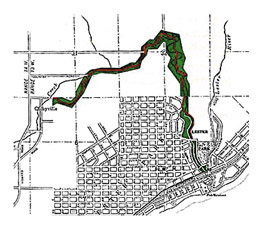

The History of Duluth, Minnesota's Seven Bridges Road

During the road's construction phase, Snively was also building a house to serve as a centerpiece to his hilltop farm.

The southwest corner of Snively's farm property bordered Amity creek. (William Overland Collection)
The only other route, the Howard Mill Road, ascended the hilltop from London Road, but was extremely steep, making the hauling of heavy loads difficult. The aesthetics of the drive were also important to Snively, however, and his plan was for his new road to eventually connect with what was then called Rogers Boulevard (Skyline Parkway) and become part of Duluth's boulevard system.
Snively (center) often joined in the manual labor, a practice he carried on into his 80's.
"The working crew composed mainly of men living in the adjacent country was all that I could wish for in the way of efficiency, for they worked faithfully and with interest and made great progress under many difficulties."
-Samuel Snively

Workmen guide teams of horses pulling plows to level the new roadway. (William Overland Collection)
By the spring of 1900 the road reached about a mile up from its starting point just north of Lester Park. Snively used delays in construction to show off the road's progress to potential fund donors.
He wanted the road to be called Spring Garden Boulevard, after a development near his farm. But the name never caught on and instead it became known as Snively Road. A remnant of the drive still exits today under that name, skirting the hillside between Glenwood Avenue and Woodland Avenue.
Snively built the road in such a way that it crossed the Amity creek in nearly a dozen places, necessitating the construction of many rustic wooden bridges such as those pictured above and below. These were the predecessor to the stone-arch bridges that exist today. (Douglas Overland Collection)
Workmen construct one of ten rustic bridges along Snively's new road in Duluth, Minn., c.1899. (Douglas Overland Collection)
Upon its completion Snively presented his new road to the city of Duluth as a designated parkway, and turned his attention to his farm and elsewhere. He had plans to build a sister route to his road on the south side of the ridge line, but these plans wouldn't reach fruition for another 30 years.